New Zealand dotterels - research and management
Research on wrybills
Other threatened shorebirds - research and management
Surveys of riverbed birds for gravel extractors
Ecology of introduced mammalian predators
Involving community groups in conservation
Advice on resource consent applications
Miscellaneous projects and advice
________________________________________________________________________________________________
New Zealand dotterels - research and management
John has undertaken research on the ecology of both northern and southern subspecies of New Zealand dotterels for more than 20 years. Much of this research has involved the use of colour-banded birds to study survival, productivity, dispersal and movement patterns. The information gathered has been used to devise and refine successful management programmes for both subspecies.
John has been science advisor to the New Zealand dotterel recovery group since its foundation in 1991. He was author of the first recovery plan for the species, and senior author of the second plan.
http://www.doc.govt.nz/upload/documents/science-and-technical/tsrp10.pdf
http://www.doc.govt.nz/upload/documents/science-and-technical/tsrp58.pdf
Advice on management of New Zealand dotterels is provided to individuals, community groups, DOC, and regional councils (notably Auckland Regional Council). Current projects include:
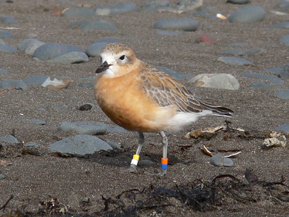
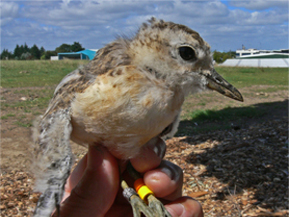
________________________________________________________________________________________________
Research on wrybills
Research on wrybills, again using colour-banded birds, has been undertaken in several South Island river systems. From 1997-2000, survival and breeding success of wrybills were measured in relation to control of mammalian predators in the Tasman and Tekapo Rivers, Mackenzie Basin. The results of this project are due to be published shortly. A similar study, measuring breeding success, was carried out in the upper Rakaia River during the 1999/00 season.
In 2003, a review was published outlining the status of the species and the threats to the population.
http://elibrary.unm.edu/sora/IWSGB/v100/p00020-p00024.pdf
In 2005, a paper was presented at the Australasian Shorebird Conference, Nelson, entitled Estimating population size and trends in the wrybill (Anarhynchus frontalis). Abstracts from the conference are shown here:
abstracts2005ASC.pdf
An invited talk on wrybill conservation was presented to the Miranda Naturalists’ Trust Open Day in October 2006. The talk was summarised at:
http://www.miranda-shorebird.org.nz/MNT%20News%20Nov%202006.pdf
Currently, a colour-banding programme is being undertaken in the Ashley and lower Waimakariri Rivers, North Canterbury, as part of the annual monitoring carried out for the Ashley/Rakahuri Rivercare Group.


________________________________________________________________________________________________
Other threatened shorebirds - research and management
John has been science advisor to the shore plover recovery group since 1997. The recovery programme currently focuses on captive-rearing, releases of juveniles on predator-free islands, and monitoring of population dynamics as these populations establish. This involves fieldwork (including colour-banding and periodic colour-band replacement), identification and assessment of suitable release sites, and monitoring of survival and productivity in the new populations.
On the Chatham Islands, shore plover work is often combined with colour-banding and monitoring of the Chatham Island oystercatcher (CIO), a Nationally Critical species endemic to the islands (e.g. Dowding & Williams 2007 - d&w07cio.pdf). John was a member of the team that reviewed the CIO management programme in 2006.
A major part of the work undertaken for the Ashley/Rakahuri Rivercare Group consists of annual monitoring of the breeding success of three threatened endemic shorebirds (wrybills, black-billed gulls and black-fronted terns) in the Ashley River.
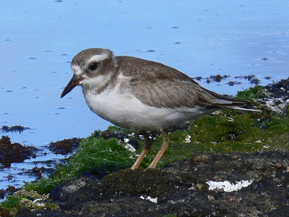

________________________________________________________________________________________________
Surveys of riverbed birds for gravel extractors
Most Environment Canterbury consents for gravel extraction in braided rivers now contain conditions requiring that extraction not take place within 100 m of any breeding birds of a number of listed species. Surveys to locate nesting birds are undertaken, and any nests found are marked off. If necessary, alternative access routes or extraction areas are identified in consultation with the consent holder. Reports are prepared and submitted to the consent holder and Environment Canterbury. More than 60 of these surveys have been undertaken since 2005. Examples of typical survey reports are shown here:
SSWoct07.pdf
taggartsashley.pdf
Surveys are also undertaken to assist gravel extraction companies with consent applications. These surveys identify areas with higher and lower bird values and are used to assist the applicant and consent authority to choose suitable extraction zones and access routes, and implement appropriate consent conditions. An example is shown here:
taggarts06.pdf


________________________________________________________________________________________________
Ecology of introduced mammalian predators
In 1990-92, New Zealand’s first radio-telemetry study of stoats was undertaken in beech forest in the Eglinton Valley, Fiordland. The study examined stoat home range size and diet, particularly in relation to beech mast seeding. Among other findings, the study revealed that juvenile stoats are capable of dispersing large distances in a short time. The results of the study were published in two papers:
http://www.nzes.org.nz/nzje/free_issues/NZJEcol18_1_11.pdf
http://www.nzes.org.nz/nzje/free_issues/NZJEcol19_2_97.pdf
In 2000-02, a second detailed study of stoats was undertaken, this time in non-forested habitat in the Tasman Valley, Mackenzie Basin. This study involved live-trapping, radio-telemetry, and the use of tracking tunnels. It examined seasonal differences in density, home range size, diet, movements, and habitat use. A small number of ferrets were also radio-tracked as part of this study.
A radio-telemetry study of ship rats was undertaken in Puketi Forest, Northland, in 1993, and the results were published at:
http://www.nzes.org.nz/nzje/free_issues/NZJEcol18_1_19.pdf
Radio-telemetry of feral cats has been carried out at a number of locations, including Tawharanui Regional Park (1994-95), the Waitakere Ranges (1995), Motuihe Island (1997) and Tuhua/Mayor Island (2000). The studies at Motuihe and Tuhua were part of monitoring programmes undertaken during pest-eradication operations on those islands.


________________________________________________________________________________________________
Involving community groups in conservation

Workshops are held and advice provided to community groups
involved in managing populations of coastal shorebirds in the North Island.
A 3-day course on management techniques used with these birds
is taught annually at the Miranda Naturalists’ Trust Shorebird
Centre. The course is run in September, and is attended by DOC
staff, regional council staff, and members of community groups. An
outline of the course is shown here:
http://www.miranda-shorebird.org.nz/Dotterel%20Poster%2009.pdf
Monitoring and research is undertaken annually for the
Ashley/Rakahuri Rivercare Group Inc., a community group
dedicated to the protection of threatened birds and their habitat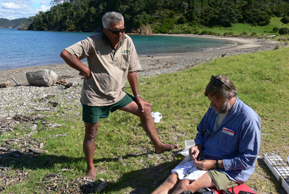
in the Ashley River, North Canterbury. In 2009, this group won
the Canterbury Aoraki Conservation Board Award.
Talks on bird ecology and conservation are given to community
and special-interest groups, such as the Ornithological Society,
Royal Forest & Bird Protection Society, and Miranda Naturalists’
Trust.
Advice was provided to the New Zealand Fairy Tern
Charitable Trust on management of fairy terns and other
shorebirds during a talk to the Trust at Mangawhai in September
2009.
________________________________________________________________________________________________
Advice on resource consent applications
 Evaluation of proposed activities or developments is undertaken to determine whether there are potential impacts on native birds, particularly coastal and riverbed species. Advice is provided on avoidance and mitigation of impacts, and on appropriate consent conditions. Expert evidence is presented to planning hearings, Environment Court hearings and mediation meetings.
Evaluation of proposed activities or developments is undertaken to determine whether there are potential impacts on native birds, particularly coastal and riverbed species. Advice is provided on avoidance and mitigation of impacts, and on appropriate consent conditions. Expert evidence is presented to planning hearings, Environment Court hearings and mediation meetings.
Assessments have been undertaken of the potential impacts on birds of a wide range of activities, including housing developments, marina construction, filming activities, sand-mining, marine farming, pest-control operations, gravel extraction, and wind farm operation. Examples of assessments and advice are shown on the publications page.
________________________________________________________________________________________________
Miscellaneous projects and advice
John is a member of the expert panel that assesses the threat status of all bird taxa breeding in New Zealand. The panel has recently published its latest 3-yearly assessment (Miskelly et al. 2008).
Advice was provided to Environment Waikato and Department of Conservation, Waikato Conservancy, on bird values of estuaries and coastal ASCVs in the region.
John was a member of an expert panel convened by the Department of Conservation in 2006 to assess biodiversity provisions during revision of the New Zealand Coastal Policy Statement.
Contributions have been made to the Department of Conservation’s Toolbox, a compendium of methods and techniques used in conservation research and management. Contributions included the introduction to the section on methods for counting birds, and two method descriptions.
A small-scale study of variable oystercatchers has been undertaken since 1994. Birds in the North Auckland region are individually colour-banded and used to study survival, dispersal, and breeding success.
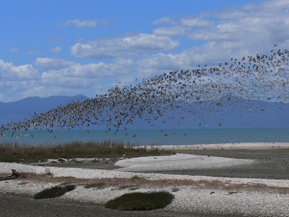
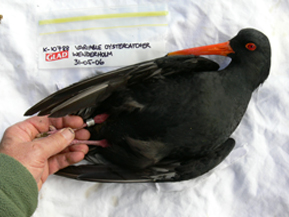
________________________________________________________________________________________________
Back to top